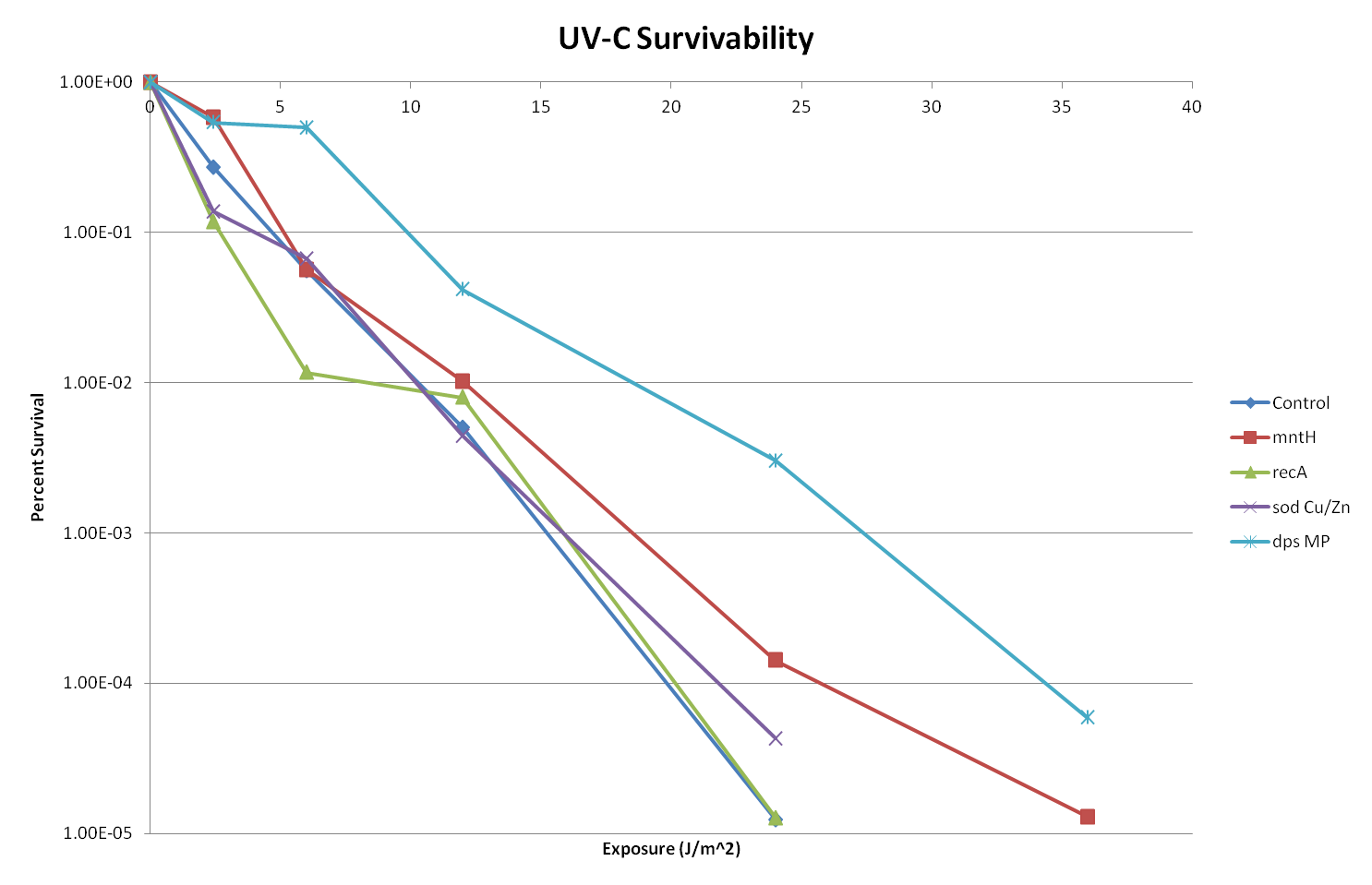Team:Stanford-Brown/HellCell/Radiation
From 2012.igem.org
(→Radiation) |
(→Radiation At a glance Extremophile: Deinococcus radiodurans Proteins of interest: Recombinase A, DNA-binding proteins from starved cells 1 and 2, Superoxide Dismutases Cu/Zn and Mn, Manganese Transporter MntH Consensus: Inconclusive) |
||
| Line 26: | Line 26: | ||
Liquid cultures of NEB5α E. coli transformed with mntH, recA, sod Cu/Zn, dps, and negative control were grown up over night at 37oC. The following day, the cells were washed and resuspended in 0.9% NaCl solution. Cell concentration was then adjusted to 10^7/mL in 5mL of a glass Petri dish. Each sample was then exposed to 1.2 J/(m^2*sec) of UV-C radiation from a UV lamp for a cumulative of 0 seconds, 2 seconds, 5 seconds, 10 seconds, 20 seconds, and 30 seconds. After each exposure, a dilution spot assay was conducted to determine the final number of surviving cells. | Liquid cultures of NEB5α E. coli transformed with mntH, recA, sod Cu/Zn, dps, and negative control were grown up over night at 37oC. The following day, the cells were washed and resuspended in 0.9% NaCl solution. Cell concentration was then adjusted to 10^7/mL in 5mL of a glass Petri dish. Each sample was then exposed to 1.2 J/(m^2*sec) of UV-C radiation from a UV lamp for a cumulative of 0 seconds, 2 seconds, 5 seconds, 10 seconds, 20 seconds, and 30 seconds. After each exposure, a dilution spot assay was conducted to determine the final number of surviving cells. | ||
| - | + | [[File:Radiation.png|800px|center]] | |
Figure 1: Displays survival of negative control, mntH construct, recA construct, sod Cu/Zn construct, and dps construct transformed E. coli after specific dosages of UV-C radiation. | Figure 1: Displays survival of negative control, mntH construct, recA construct, sod Cu/Zn construct, and dps construct transformed E. coli after specific dosages of UV-C radiation. | ||
Revision as of 08:15, 3 October 2012
Radiation
At a glance
Extremophile: Deinococcus radiodurans
Proteins of interest: Recombinase A, DNA-binding proteins from starved cells 1 and 2, Superoxide Dismutases Cu/Zn and Mn, Manganese Transporter MntH
Consensus: Inconclusive
Deinococcus radiodurans is an extremely radiation-resistant bacterium: while about 10 Gy (absorbed radiation dose, Gray) can kill most vertebrates, D. radiodurans can withstand up to 12,000 Gy. Current literature supports this finding with D. radiodurans’ unique genetic makeup which allows it to better handle radiation exposure. The two main effects of radiation exposure to bacterial cells are DNA damage and the creation of toxic superoxide species (Daly 2009). Two DNA damage prevention and repair proteins in D. radiodurans have been shown to outperform analogs in less radiation tolerant bacteria. The recombinational repair protein Recombinase A from D. radiodurans is much more effective at protecting DNA from damage than that from E. coli (Slade and Miroslav 2011). By binding to DNA, the proteins Dps-1 and Dps-2 (DNA-binding proteins from starved cells) protects it from the reactive superoxide species formed by ionizing radiation (Slade and Miroslav 2011). To take care of the pesky superoxides, superoxide dismutases are expressed in high levels in D. radiodurans (Slade and Miroslav 2011). These enzymes break the reactive species down into harmless oxygen and hydrogen peroxides. There are two different types of these dismutases in D. radiodurans, one which uses copper and zinc as cofactors and another that uses manganese (Gao, Zhang, Song, Chen, and Zhong 2009). Manganese is cofactor for many other radiation stress mechanisms in the cell, and so manganese transporters bring manganese into the cell during radiation stress. These transporters are particularly well-known in D. radiodurans, and expressing these proteins in E. coli has shown promise (Haiyan and Baoming 2010).
So the Hell Cell squad assimilated all of this information to isolate the genes for recA, Dps-1, Dps-2, Sod Cu/Zn, Sod Mn, MntH from Deinococcus radiodurans and put them into the Test Plasmid for expression in E. coli.
Assay
Liquid cultures of NEB5α E. coli transformed with mntH, recA, sod Cu/Zn, dps, and negative control were grown up over night at 37oC. The following day, the cells were washed and resuspended in 0.9% NaCl solution. Cell concentration was then adjusted to 10^7/mL in 5mL of a glass Petri dish. Each sample was then exposed to 1.2 J/(m^2*sec) of UV-C radiation from a UV lamp for a cumulative of 0 seconds, 2 seconds, 5 seconds, 10 seconds, 20 seconds, and 30 seconds. After each exposure, a dilution spot assay was conducted to determine the final number of surviving cells.
Figure 1: Displays survival of negative control, mntH construct, recA construct, sod Cu/Zn construct, and dps construct transformed E. coli after specific dosages of UV-C radiation.
Conclusions
The results of assaying constructs which convey radiation resistance seem to indicate that there may be one part that is successful. In Figure 1, it can be clearly seen that E. coli transformed with the dps construct tend to survive at higher percentages at a given UV-C dosage. 10% survivability is witnessed in all constructs other than dps at levels lower than 5 J/m^2; however, these results seem to indicate that dps may have 10% survivability at levels as high as 10 J/m^2. In this assay, only one replicate of each sample was able to be assayed; however, future assays have given conflicting and inconsistent results. For example, further assays seem to display an inconsistency in survivability and UV-C dosage. Thus, although this assay may indicate that the dps construct conveys radiation resistance, further and more accurate assays need to be conducted in order to reach a definitive conclusion.
 "
"
